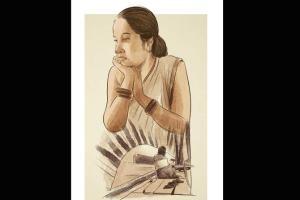A gifted photographer with a discerning eye, the late Manobina Roy was also the wife of distinguished filmmaker Bimal Roy and mother of Joy Roy, Aparajita Sinha, Yashodhara Roy and Rinki Bhattacharya

Illustration/Uday Mohite
 Last week, I attended the superb photography exhibition, A Woman and Her Camera: The Photography of Manobina Roy, at Artisans' Art Gallery, which runs till December 4. A gifted photographer with a discerning eye, the late Manobina Roy was also the wife of distinguished filmmaker Bimal Roy and mother of Joy Roy, Aparajita Sinha, Yashodhara Roy and Rinki Bhattacharya.
Last week, I attended the superb photography exhibition, A Woman and Her Camera: The Photography of Manobina Roy, at Artisans' Art Gallery, which runs till December 4. A gifted photographer with a discerning eye, the late Manobina Roy was also the wife of distinguished filmmaker Bimal Roy and mother of Joy Roy, Aparajita Sinha, Yashodhara Roy and Rinki Bhattacharya.
ADVERTISEMENT
Although her photographs were published in magazines in her lifetime (1919-2001), she remained under the shadow of her famous husband. Joy has written of how they had had an exhibition of Bimal Roy's photographs at the Nehru Centre in 2000. Their mother sat in a corner of the gallery, expressionless. "No one has ever done this for my photos," she said. That's when Joy resolved that he would organise an exhibition of her photographs. The current exhibition, he said, was mainly due to the efforts of MC Mohan, a professor and art historian.
Returning from the show, I was reminded of Bengali writer Rokeya Sakhawat Hossain's delightful, radical, feminist story, Sultana's Dream, written way back in 1905. She describes Ladyland, run by women who, instead of organising military conquests like the men, focused on scientific discoveries to solve problems—a balloon to collect rain, an instrument to collect 'sun-heat' and they travel by 'air-car'. The men, packed off in 'mardana' (as against zenana) cook and look after babies. I was mulling over the possibilities that open up when a woman comes into her own.
When Manobina Roy was gifted a Brownie camera for her 12th birthday, it set her on the path to becoming one of India's earliest known women photographers. A contemporary of India's first woman photojournalist, Homai Vyarawalla, Roy's articles and photographs were published in Shochitro Bharat, The Illustrated Weekly of India
and Femina.
The beautifully printed black and white photographs, with a real eye for capturing light and shade, cover a range of subjects. These include portraits of Jawaharlal Nehru, Vijaya Lakshmi Pandit and VK Krishna Menon, indicating her access to the corridors of power. There are photographs of landscapes and people in Switzerland, London, Moscow and India, portraits of Bimal Roy and endearing portraits of the children. My favourite is of a young girl, photographed from the back, as she sits on the deck of a sail boat, its sails billowing in a dramatic arc. I call it the 'Titas' photograph, as it reminds me of Ritwik Ghatak's film Titas Ekti Nadir Naam (A River Called Titas).
The highlight of the evening was actor Dilnaz Irani's spirited reading of highlights from Manobina Roy's diary, of her wondrous childhood in Ramnagar, then capital of Benares state, ruled by a maharajah. Of the time she and her twin sister Debalina accompanied their dad—on the back of an elephant sent by the Maharajah—to attend the Ram Lila. Or, when their dad took them to the Maharajah's mujras, and the girls mimicked the gorgeous baijis, much to the horror of their mother. And when they made mango twig bridges over rain puddles for passenger ants to cross over. The photographs and words transported us to a magical world, in which we lingered for long.
Meenakshi Shedde is India and South Asia Delegate to the Berlin International Film Festival, National Award-winning critic, curator to festivals worldwide and journalist. Reach her at meenakshi.shedde@mid-day.com
Catch up on all the latest Crime, National, International and Hatke news here. Also download the new mid-day Android and iOS apps to get latest updates
 Subscribe today by clicking the link and stay updated with the latest news!" Click here!
Subscribe today by clicking the link and stay updated with the latest news!" Click here!






